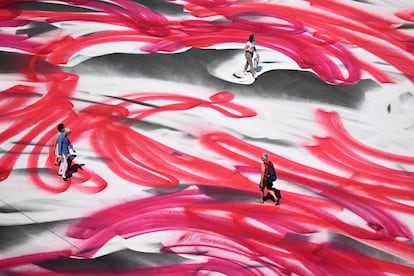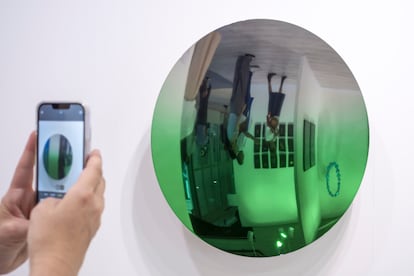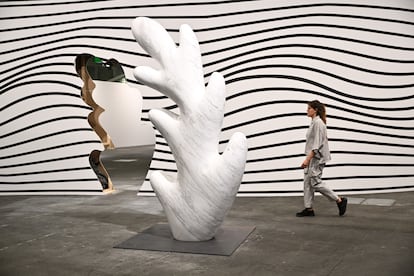Artificial intelligence begins to paint in art


Crossing that valley of ashes that is the Spanish contemporary art market, higher up, in the heart of the Alps, Art Basel ( Art Basel 2025) closed another edition of major sales last June. Switzerland is a safe haven for gallery owners. Secure transactions. Despite geopolitics, the war in Ukraine, the Middle East, or Trump's tariffs , private jets continue to land with major collectors. But this year there was a difference: artificial intelligence has arrived. It allows them to instantly know the final price of any work auctioned worldwide. Collectors use it to find out the remaining values because the data they collect comes only from auctions, as gallery prices are not provided to these platforms. Emerging artists, for example, are left out. There, the cost is established between gallery owner and client when they are left alone conversing with the grammar of money.
Jorge Pérez (Cuban-American), a leading real estate developer on the East Coast of the United States, and his wife, Darlene, a hepatologist and granddaughter of a grandmother from the Canary Islands, are some of the most sought-after collectors and patrons in Basel. They buy, and a lot. Pérez carries a cell phone, with a dark plastic cover, on which, sorted by artist name, he references the works they own. There are hundreds and hundreds of pieces on that phone. If he sees one that interests them, he sends it to his team of curators, led by Patricia Hanna (he has his own museum, Pérez Art Museum Miami or PAMM, and also Espacio 23). The cell phone houses one of the world's largest private collections of contemporary art, owned by some of the richest Latin Americans ($2.6 billion, approximately €2.2 billion, according to Forbes magazine ).
This year, in Basel, he reveals, he has acquired 24 pieces for a value of $643,904 (€549,800). And still to be counted are two works by the American painter Wade Guyton (Indiana, 1972), which could double that figure, and a mural by Peruvian Claudia Martínez Garay ( Conversaciones , 2025). The terminal offers them the information they need on past auctions. "It's an instrument and it gives you a series of data, although it is chosen with the heart," says Pérez in front of a work in the Art Unlimited section, which displays the largest pieces and installations.

For some years now, it's been common to see collectors, like Jorge Pérez and his wife, using comparators. But artificial intelligence has emerged, more out of curiosity than force. The MutualArt.com platform is one of these applications that uses AI . The only one—according to its own statements—on the market. "AI will impact art buying in many ways, primarily through a combination of the ability to identify and classify data in unprecedented ways, and unlimited access to art literature, history, and prices," reflects Tal Yahav, product director at MutualArt.com. He adds: "The most significant impact is AI's ability to capture the essence of a work of art by identifying its main motifs, objects, and styles. Subsequently, vast sources of artistic information can be accessed to classify the work." Another advantage is the ease of instantly knowing, based on the history of repeat sales, the price of the same or similar pieces.

Artificial intelligence won't reduce speculation about artists and is still far from predicting the future of an artist or a work. "However, these platforms are no substitute for experience and knowledge, so collectors just starting out shouldn't rely solely on AI," warns Monica Heslington, head of art and collectibles at Goldman Sachs Private Wealth Management . "They should also consult experts who can provide context for the price data and background information provided by AI, and who can also analyze whether there are any potential issues with provenance, authenticity, or condition."
It's the age-old demand of the lifelong connoisseur . "They're useful references, but they're basically just that, references. Choosing will always take into account more than just possible economic predictions," observes Maribel López, director of ArcoMadrid . The collector (450 works) Paco Cantos uses the Artsy platform. "It's a guide; in the end, I make the decision. The only artificial intelligence I trust is my own successes and mistakes," he concludes. It's art, not mathematics.
EL PAÍS





